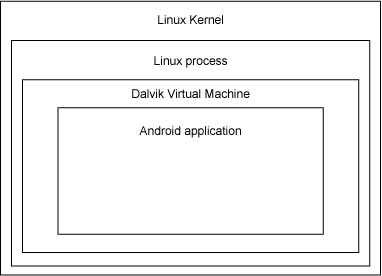Android Tutorial-Application architecture
Android Tutorial -Application architecture
As mentioned, Android runs atop a Linux kernel. Android applications are written in the Java programming language, and they run within a virtual machine (VM). It’s important to note that the VM is not a JVM as you might expect, but is the Dalvik Virtual Machine, an open source technology. Each Android application runs within an instance of the Dalvik VM, which in turn resides within a Linux-kernel managed process, as shown below.
An Android application consists of one or more of the following classifications:
- Activities
- An application that has a visible UI is implemented with an activity. When a user selects an application from the home screen or application launcher, an activity is started.
- Services
- A service should be used for any application that needs to persist for a long time, such as a network monitor or update-checking application.
- Content providers
- You can think of content providers as a database server. A content provider’s job is to manage access to persisted data, such as a SQLite database. If your application is very simple, you might not necessarily create a content provider. If you’re building a larger application, or one that makes data available to multiple activities or applications, a content provider is the means of accessing your data.
- Broadcast receivers
- An Android application may be launched to process a element of data or respond to an event, such as the receipt of a text message.
An Android application, along with a file called AndroidManifest.xml, is deployed to a device. AndroidManifest.xml contains the necessary configuration information to properly install it to the device. It includes the required class names and types of events the application is able to process, and the required permissions the application needs to run. For example, if an application requires access to the network — to download a file, for example — this permission must be explicitly stated in the manifest file. Many applications may have this specific permission enabled. Such declarative security helps reduce the likelihood that a rogue application can cause damage on your device.
The next section discusses the development environment required to build an
Android application.
This Android Tutorial has been taken from IBM Android Tutorial




